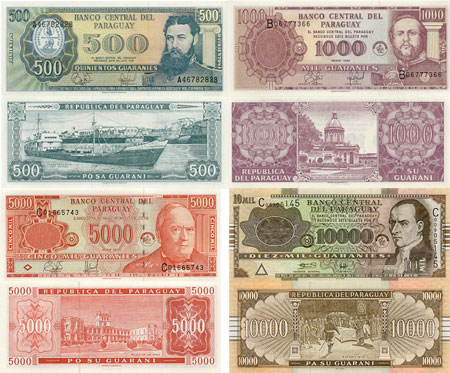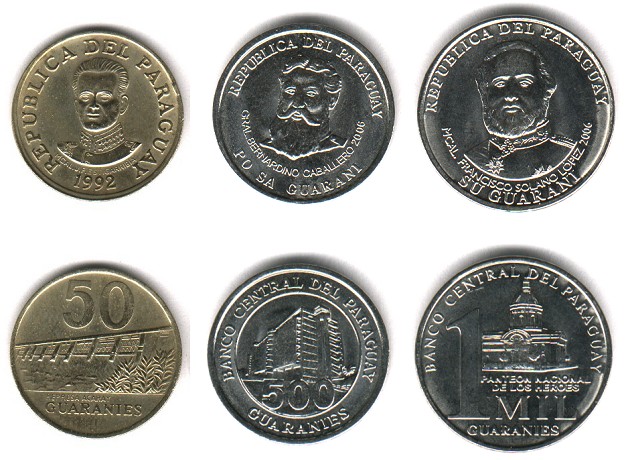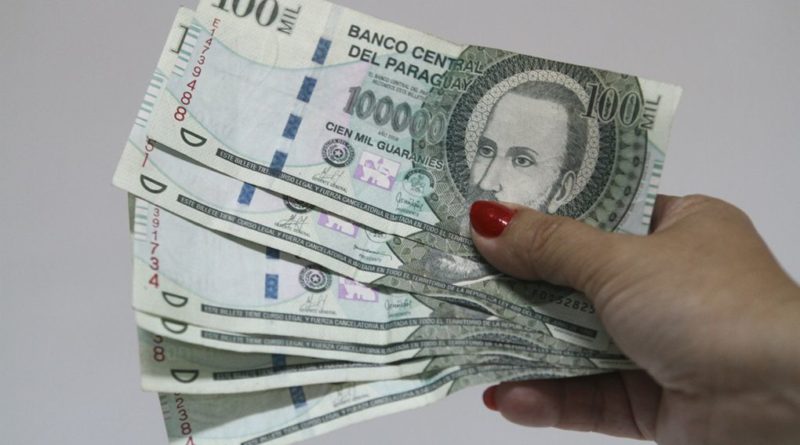Paraguay’s economy has seen its share of ups and down, especially in the last ten years. Paraguay’s currency is called the “Guarani” (code PYG), like the name of the native populations, and it is one of the least valued currencies in South America. Because of this, the tourist traveling to Paraguay is likely to exchange a lot of guarani for mere dollars. You will probably be very surprised at the inexpensive shopping markets in the Paraguayan cities.
The guarani was created in 1943 and has seen wide variations in value. The first guarani were aluminum coins, and in 1953 they were replaced with scalloped coins. For nearly 25 years between 1960 and 1985, the guarani to US dollar was rated at 126 guarani to 1 dollar. In 1990, aluminum coins were replaced with stainless steel, and in 1990, they were replaced with brass-plated steel and a nickel-brass mixture. The first guarani paper notes were added to Paraguay’s economy in 1990. Since then, over 2000 guarani notes have been fueled into the economy.

In 2004, major security changes evolved the Paraguayan guarani money note. Similar to US security measures, new Paraguayan notes have borderless underprint and a safeguard border along the ridge. In 2005, the Paraguayan Central Bank had to declare 50,000 notes valueless due to criminal distribution prior to print. Starting in 2009, Paraguay began producing polymer notes instead of the traditional cotton ones.
Paraguayan commerce is driven by Argentina, Bolivia and Brazilian export. The economy fluctuates widely at times, driven mostly by nature and the farming countryside. When drought conditions exist, the economy suffers and Paraguay’s currency becomes less valuable. As such, foreign currency has become very popular in Paraguay because of its relative stability in comparison to guarani.
As a traveler in Paraguay, the symbol for guarani is PYG. In 2010, the average exchange rate is 4,800 guarani per each US $1. Ironically, many locals prefer to use foreign currency for added stability. Be sure to convert any currency you carry in Asuncion or Encarnacion. In the cities of the eastern Paraguay, most shops will accept US currency. In the countryside, you’re more likely to run into guarani-only shops. Do not anticipate using your credit card very much, as many shops do not accept them.

Another good tip to anticipate during travel in Paraguay is the short hours most Paraguayan banks are open. It’s safe to assume most banks will be open between 10 am to 4 pm, but it’s not uncommon for banks to be closed on Saturdays, or to close early unannounced. In the countryside (for example, in the Chaco district), banks become even more widespread and sporadically operational. Since guarani is more widespread in these less-populated regions, most travelers will recommend getting guarani in the city banks first before traveling to Chaco.
Paraguay’s open attitude towards tourism allows many travelers to use their own currency without needing to convert to PYG. Be prepared to use cash and be careful to check with what currency is preferred in your destinations. You’ll find your travels worry-free with a little bit of pre-planning.

